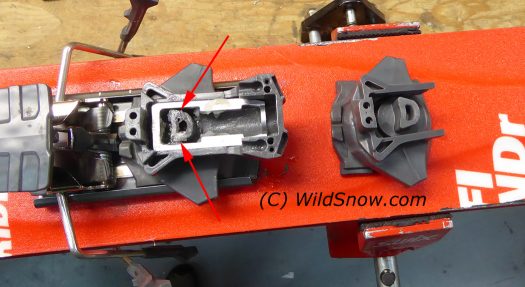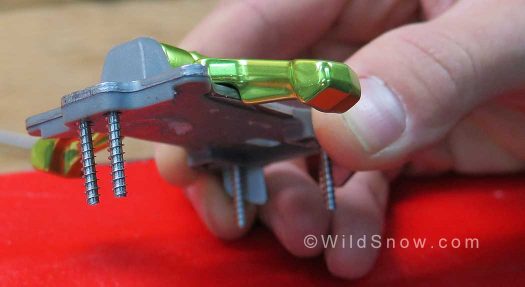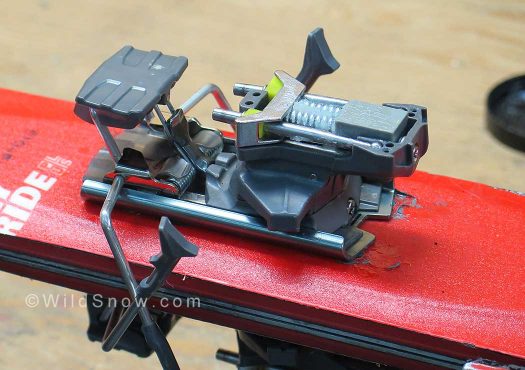(This post sponsored by our publishing partner Cripple Creek Backcountry.)

The new ZED 12 ski touring binding by G3 is based on the Lost Binding of Z, that storied apex of design that only lived in legend — until the persistence of G3 paid off.
Ski touring gear archaeologists across the world sifted through dusty parts bins, dug like starving gold prospectors through European industrial dumping grounds, and even excavated through the sifting bone dust of ancient tombs. The search at times appeared endless — ultimately taking nearly half a century.
All quested for the Lost Binding of Z, a fabled amalgam, rumored to have been created by mad engineer Mac Ztrif 50 years ahead of his time. A man who in lieu of modern computerized machining would carve perfect prototype ski binding parts using only a sharp pocket knife and dense knotwood harvested from secret groves in the high Alps of Slovenia.
I thought this was BS, but reliable insider sources tell us G3 had secret agents seeded throughout the world. When a grizzled grave robber excavated what proved to be the Z, the Canadians were as quick on the patent licensing bid as they are on their hockey blades, thus snatching this amazing technology from the hands of their competitors.
Using the Lost Z binding as a point of departure, in little more than 12 months the Vancouver vanguard had a modern version of the ZED 12 ski touring binding they now announce, with plans to retail beginning fall of 2018. What blows my mind is how similar this is to the ION, only I lost count of the subtle improvements. Yeah, it took fifty years, but we have finally reached ZED!
What’s remarkable about the ZED is how close it is in engineering and appearance to the G3 ION. Indeed, the ZED toe unit is exactly a stripped down ION toe with the same excellent geometry and jaw closing force.
Heel unit is quite different, however, it being significantly lighter, but more, integrating both sideways and upwards release value adjustment into one spring and one adjustment. This is not easy, but clearly the way any lighter weight modern tech binding heel should be configured.

Heel unit is more of a departure. It’s mostly composite material boasting such benefits as one screw adjustment for both side and upwards release, a full 10 millimeters of ski flex compensation, and 30 mm of boot length adjustment (62 mm range for demo plate, at a horrible penalty of 5 grams.

ZED heel unit as viewed from bottom, showing how the optional brake attaches and so forth. Brake install-remove requires removal of binding base from ski, but it looks overall excellent thus worth the hassle as compared to other solutions with mixed results.

As with ION, G3 goes beyond what would be required by TUV certification in that each and every binding’s release-retention force is measured, _before_ the adjustment scale indicator mark is laser etched. The indicator mark is then placed in position so it matches up to the correct number on the scale for a given release value. Result is clearly one of the most accurately calibrated bindings on the market. (Notice in this photo how the white indicator marks do not match position from binding to binding, that’s because they’re positioned where they belong, not where someone in the art department decided to paint them.

This is one of the G3 calibration stations where they measure actual release values of every single binding. Each binding is barcoded and serial numbered. The laser etcher reads the barcode and thus knows where to “paint” the adjustment indicator mark. Impressive.

True to WildSnow tradition, we did a teardown with the G3 engineers. This is the heel with top plate and springs removed, showing the tiny metal frame which moves against the grey plastic cam lobes, thus reversing the direction of force so the springs can be used for both vertical and lateral release. If that’s confusing, you are not alone. Takeaway, this is adult mechanical engineering.

Top plate is held down with thin screws into plastic. Clearly this could be a weak point as we’ve seen countless other times in the industry. G3 engineers showed us results of “can opener” testing during which they rip the top plate off the binding. They assured us that any fatigue of the screws or plastic required an enormous number of test cycles at normal skier weights, and the plastic failed at high force levels before the screws. That’s encouraging but we’ll need to see early adopter consumer testing before we’re entirely convinced.

With top plate removed, upper part is similar to other classic tech bindings. Secret sauce is the cam system as shown in photos above, that allows use of one screw for both vertical and lateral release-retention values adjustment. Note that as with ION, all ZED adjustments are done with pozidrive #3 — brilliant. All mounting screws are pozi stainless, not our favorite (too fragile in our opinion) but they look nice and don’t corrode.

Bonus photo. If you were in Chile last summer you might have seen a G3 binding tester with a calculator and load cell riding these $3,000 one-off machined protos. Be glad we have things like injection molding and mass production to bring the price down somewhere in the ecosphere as $449.00 with brakes (see below for brake sizes).
Other thoughts:
The astute consumer of ski touring bindings will no doubt ask “why not just ski an ION?” Several reasons you might go one way or the other on that. Firstly, with ION LT (no brake) you’ll pay a weight penalty of about 114 grams (4 ounces) per foot, which is not insignificant. G3 says the ION might be more suitable for hard charging while ZED is clearly more on the ski touring side of the equation, and thus you get a smidge of durability for the weight price. I’m not entirely convinced that’s a factor for most shoppers, though ION parts such as the toe unit chassis and heel top plate are obviously stronger. A more subtle difference is that ION ingeniously locks out its ski flex compensation while in touring mode, thus preventing possible wear inducing fore/aft movement of the heel unit while in touring mode. Also, as I alluded to elsewhere, due to the virtually zero ramp of the ZED, the heel lifters are probably slightly lower than ION (though we do need to do some measuring on that).
In the end, if ZED proves out, that might simply be proof that ION could be lighter. We shall see. My favorite thing about ION is unlike ZED’s admittedly clever one-screw release value adjustment, you have two independent adjustments and can thus tune release values — something I’ve found quite useful in convincing tech bindings to perform at “chart” release-retention values (and as one commenter mentioned, is useful if you find the brake might be influencing your lateral release resistance). ZED reduces weight and enhances simplicity by combining adjustments into one, but everything comes at a price.
Another thing some of you might care about, ION provides 22 mm boot length adjustment while ZED offers 30. In my view that’s significant. More, you can run ZED with longer demo plate, thus enjoying 62 mm of boot length adjustment for a few grams weight increase per binding. That’s impressive, in fact it’s nothing less than proof that concepts gleaned from the Lost Binding of Z are as timely now as they were when Mac Ztrif whittled that first prototype so long ago.
Conclusion: To say we are excited about this binding is to put it mildly. It appears to be a wonderful contribution, and will no doubt rise to the top choices in the mob of classic tech bindings you’ll be able to choose from beginning fall of 2018. Wildsnow did ski the ZED a few days ago, we’ll report on that in a separate blog post. This is clearly one of the lightest tech binding yet to offer such a robust combination of features, e.g., fully adjustable release to RV 12; flex compensation; wide range boot length adjustment; 3 climbing lift positions including heel flat on ski; optional brake; G3 toe jaw retention features. And, it’s designed and assembled in North America.
Let’s do the numbers:
— “ZED” zero theme continues in the ZED’s ramp angle. Check out our chart. Ramp angle of this binding is virtually zero! That’ll keep some of you happy, while some skiers may want the heel stacked a few millimeters to get the ramp feel they’re used to (me). Bear in mind that binding ramp influences how high the climbing heel lift will feel, in this case we suspect you’re not going to feel stilted to the stratosphere when invoking the high lift, measurement on that is coming.
— Verified weights, retail version:
—- Toe 128 grams (4.5 oz) no crampon mount, with screws.
—- Heel 246 grams (8.7 oz) with screws.
—- Brake, 115 mm, 86 grams (3.0 oz)
— Available brakes: 85,100,115,130 mm.
— Release values (RV) 5-12.
— Ski flex compensation 10 mm (known as “forward pressure” to those who don’t understand).
— Boot length adjustment range 30 mm, 62 with demo plate at only 25 grams weight increase per binding (pre production weight).
— Mounting screw pattern same as ION, wide, heel 36.5 mm, toe 40 mm.
ZED trivia: We couldn’t help but ponder the symbolism of ZED. Obviously, the word signifies Canada, where it’s a matter of national pride to utter “zed” instead of “zee” in speech. But consider that Z can mean zero, and this coming season G3 will be for the first time in their history make zero telemark bindings — no doubt due in part to the resources they’ve expended on ZED. More, consider that ZED combines both My (vertical) and Mz (lateral) release under one mechanical, thus bringing us one setting for both y and z. Lastly, for 2018 anyway this could be the last word in lightweight yet fully functional tech bindings, and what is last is sometimes first. Z — Zero — G3 ZED.
WildSnow.com publisher emeritus and founder Lou (Louis Dawson) has a 50+ years career in climbing, backcountry skiing and ski mountaineering. He was the first person in history to ski down all 54 Colorado 14,000-foot peaks, has authored numerous books about about backcountry skiing, and has skied from the summit of Denali in Alaska, North America’s highest mountain.










